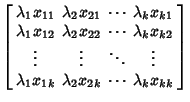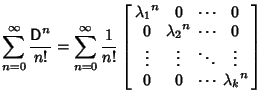| 释义 |
EigenvalueLet  be a linear transformation represented by a Matrix A. If there is a Vector be a linear transformation represented by a Matrix A. If there is a Vector  such that such that
 | (1) |
 , then , then  is the eigenvalue of A with corresponding (right) Eigenvector is the eigenvalue of A with corresponding (right) Eigenvector . Letting A be a . Letting A be a  Matrix, Matrix,
 | (2) |
 , then the corresponding Eigenvectors satisfy , then the corresponding Eigenvectors satisfy
 | (3) |
 | (4) |
 | (5) |
As shown in Cramer's Rule, a system of linear equations has nontrivial solutions only if the Determinantvanishes, so we obtain the Characteristic Equation
 | (6) |
  s are different, then plugging these back in gives s are different, then plugging these back in gives  independent equations for the independent equations for the  componentsof each corresponding Eigenvector. The Eigenvectors will then be orthogonal and the systemis said to be nondegenerate. If the eigenvalues are componentsof each corresponding Eigenvector. The Eigenvectors will then be orthogonal and the systemis said to be nondegenerate. If the eigenvalues are  -fold Degenerate, then the system is said to be degenerate andthe Eigenvectors are not linearly independent. In such cases, the additional constraint that theEigenvectors be orthogonal, -fold Degenerate, then the system is said to be degenerate andthe Eigenvectors are not linearly independent. In such cases, the additional constraint that theEigenvectors be orthogonal,
 | (7) |
 is the Kronecker Delta, can be applied to yield is the Kronecker Delta, can be applied to yield  additional constraints, thus allowing solutionfor the Eigenvectors. additional constraints, thus allowing solutionfor the Eigenvectors.
Assume A has nondegenerate eigenvalues  and corresponding linearly independentEigenvectors and corresponding linearly independentEigenvectors  which can be denoted which can be denoted
 | (8) |
 | (9) |
 | (10) |
 is a Diagonal Matrix. Then is a Diagonal Matrix. Then
so
 | (12) |
By induction, it follows that for  , ,
 | (14) |
 | (15) |
 | (16) |
 . .
A further remarkable result involving the matrices  and and  follows from the definition follows from the definition
Since D is a Diagonal Matrix,
 can be found using can be found using
 | (19) |
Assume we know the eigenvalue for
 | (20) |
 | (21) |
 . Multiplying A by a constant . Multiplying A by a constant 
 | (22) |
 . .
Now consider a Similarity Transformation of A. Let be the Determinant of A, then be the Determinant of A, then
so the eigenvalues are the same as for A.See also Brauer's Theorem,Condition Number, Eigenfunction, Eigenvector, Frobenius Theorem,Gersgorin Circle Theorem, Lyapunov's First Theorem, Lyapunov's Second Theorem,Ostrowski's Theorem, Perron's Theorem, Perron-Frobenius Theorem, Poincaré SeparationTheorem, Random Matrix,Schur's Inequalities, Sturmian Separation Theorem, Sylvester'sInertia Law, Wielandt's Theorem
References
Arfken, G. ``Eigenvectors, Eigenvalues.'' §4.7 in Mathematical Methods for Physicists, 3rd ed. Orlando, FL: Academic Press, pp. 229-237, 1985.Nash, J. C. ``The Algebraic Eigenvalue Problem.'' Ch. 9 in Compact Numerical Methods for Computers: Linear Algebra and Function Minimisation, 2nd ed. Bristol, England: Adam Hilger, pp. 102-118, 1990. Press, W. H.; Flannery, B. P.; Teukolsky, S. A.; and Vetterling, W. T. ``Eigensystems.'' Ch. 11 in Numerical Recipes in FORTRAN: The Art of Scientific Computing, 2nd ed. Cambridge, England: Cambridge University Press, pp. 449-489, 1992. |
![]() be a linear transformation represented by a Matrix A. If there is a Vector
be a linear transformation represented by a Matrix A. If there is a Vector ![]() such that
such that


![]() and corresponding linearly independentEigenvectors
and corresponding linearly independentEigenvectors ![]() which can be denoted
which can be denoted





![]() and
and ![]() follows from the definition
follows from the definition




![]() can be found using
can be found using
![]() be the Determinant of A, then
be the Determinant of A, then